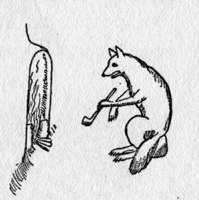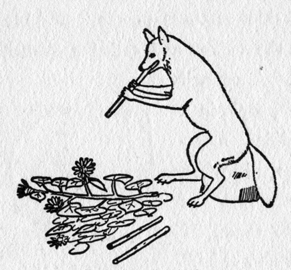O-way-way-ham-by-yoh, a fox, was living near an Indian village when the chief of the Indians died.
"Now I shall be chief of those people," said the fox; so he went to the village and called a council of all the Indians. A council means a meeting of people in a house; and the Indians' meeting house is the kiva. So when all the Indians came into the kiva, the fox said to them, "I am going to be your new chief." The Indians talked it over and said all right. But when the fox left the council, the Indians changed their minds and decided that they did not want the fox to be their chief.

"I am going to be your new chief"
They sent a messenger to the fox and told him that he could not be their chief, for they had changed their minds about it.
The fox was sorry to hear the message, but he was determined to be chief of the Indians.
So the fox went out and gathered sunflower stalks. He took them to his den and began making flutes out of them. He blew on each flute that he made; and he kept throwing them away and throwing them away, because he did not like the tone of them. At last he made one that he liked, for it had a beautiful soft tone. He put it carefully away in his den. Then he went to the Indian village and told the Indians, "If I am not made your chief in four days, the water from the lake will come up and drown you."

It was the fox playing
The Indians did not believe what the fox said. They held another council in the kiva, and again sent word to the fox that he could not be their chief.
The fox then set to work and dug a tunnel – a long hole under the ground – almost to the edge of the lake. He took his flute – the sweet-toned one he had made from the sunflower stalk – and went into the tunnel. There was just a little bit of ground between him and the water in the lake.
Early the next morning an Indian went to the lake to get a jar of water. He heard a flute song coming out of the lake. It was the fox playing, but the Indian thought it was the water-god playing this tune:

The Indian ran back to the village and told the other Indians what he had heard; but they did not believe him.
The next morning another Indian went to the lake for water. He heard the fox playing on his flute in the tunnel. Again it sounded as if the water-god were playing in the lake. This Indian went back and told all the Indians what he had heard; but still they did not believe it was true.
But on the third morning, the two Indians who had heard the music by the lake asked many of the Indians to go down to the lake with them to listen for the water-god's music. The Indians went down and they heard the fox playing again. They all believed it was the water-god; so when they got back to the village, they called a council. They told all of the Indians:
"We have heard the music of the water-god. The fox told us that if he were not made our chief in four days, the water would come up out of the lake and drown us. The water-god is playing his flute. What the fox said must be true. The fox must be made our chief before tomorrow."
All the Indians agreed. They sent a messenger to the fox and told him to come and be chief. But the fox pretended he did not want to come. He wanted all of the Indians to come together to his den to invite him to be their chief.
That night the fox broke the ground away at the end of the tunnel, right next to the lake, so that the water could run into the tunnel.
When the Indians awoke the next morning, they heard the water rushing under the ground near them. They thought the water from the lake was coming to drown them; for it was the fourth day and the fox had not been made their chief. They all ran down to the fox's den just as fast as they could. They begged him, "Oh, please, Mr. Fox, come and be our chief, so that we may not be drowned!"
"If you are quite sure that you want me for your chief, I'll come," replied the fox.
"Oh, we are quite sure, quite sure, Mr. Fox!"
That was just what the fox wanted; so he went to the village with the Indians and they made him their chief and he ruled long and well and wisely.
This chapter has been put on-line as part of the
BUILD-A-BOOK Initiative at the
Celebration of Women Writers.
Initial text entry and proof-reading of this chapter were the work of volunteer
Mary Mark Ockerbloom.